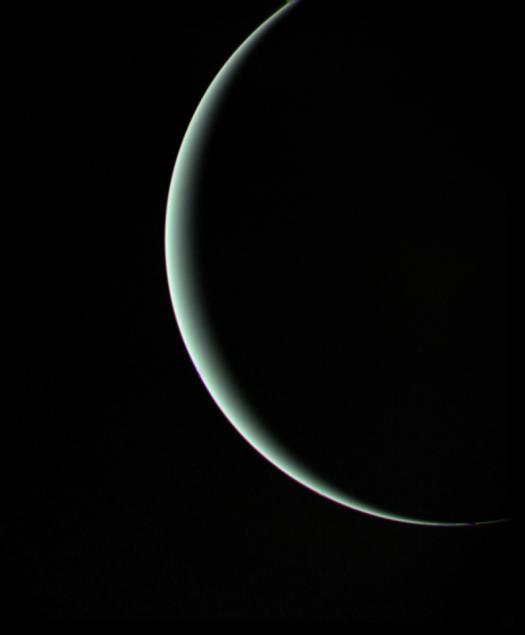







| BOOKS | F. A. Q. | ARTICLES | TALKS | ABOUT KEN | DONATE | BEYOND OUR KEN |
|---|
By Ken Croswell
Published on New Scientist (September 4, 2017)

Credit: Voyager 2. NASA and JPL.
Pity poor Cressida – not the tragic figure in Shakespeare, but a small moon orbiting Uranus. It looks like it will crash into another of the planet’s moons in a mere million years.
The Voyager 2 spacecraft discovered Cressida in 1986. It is just 82 kilometres across, dark in colour, and orbits close to Uranus but beyond most of its rings. It belongs to the most tightly packed group of satellites in the solar system, nine moons whose orbits all lie within 18,000 kilometres of one another.
Now Robert Chancia at the University of Idaho and his colleagues have deduced the small moon’s mass – and from it discovered the probable shape of its demise.
The team started by investigating one of the planet’s rings, called Eta, and found that its orbit is slightly triangular rather than perfectly circular. “We didn’t really expect to find that,” Chancia says.
Distorted ring
They believe Cressida’s gravity is behind the distortion, as it keeps pace with the moon’s orbit of Uranus. In contrast, the individual particles that make up the ring revolve faster than the moon, completing three orbits in the same time the moon takes to complete two orbits.
This link enabled the team to use the ring to deduce the moon’s mass, the first time anyone has weighed such a small moon of Uranus. They found that Cressida is about 1/300,000th as massive as Earth’s Moon and about 86 per cent as dense as water. That’s much denser than the small moons of Saturn, which are mostly made of water ice but are porous, making them lighter than ice.
Cressida is probably porous as well. “It’s too small to crush out its porosity through self-gravity, so there’s got to be more stuff than ice there,” says William McKinnon at Washington University in St. Louis, Missouri, who wasn’t involved in the work.
“There’s got to be rock, probably carbonaceous stuff, and that fits in with the fact that all those small moons and the rings themselves are so dark, so different compared to Saturn’s rings,” says McKinnon.
Desdemona’s doom
The findings spell trouble for Cressida. The denser Uranus’s closely packed moons, the more their gravity tugs at one another, raising the spectre that one will swerve into the wrong lane. “Some of these moons are probably going to crash into each other,” says team member Matthew Hedman, also at the University of Idaho.
In only about a million years, Cressida will probably strike Desdemona, a moon that orbits just 900 kilometres outside Cressida’s path, says the team. A similar fate awaits the moons Cupid and Belinda, which will hit each other.
Furthermore, says Chancia, “there’s actually evidence of past collisions.” Two diffuse rings near the moons could be made of debris from previous smash-ups.
Ken Croswell earned his Ph.D. in astronomy from Harvard University and is the author of The Alchemy of the Heavens and The Lives of Stars.
"An engaging account of the continuing discovery of our Galaxy...wonderful." --Owen Gingerich, The New York Times Book Review. See all reviews of The Alchemy of the Heavens here.
"A stellar picture of what we know or guess about those distant lights."--Kirkus. See all reviews of The Lives of Stars here.
| BOOKS | F. A. Q. | ARTICLES | TALKS | ABOUT KEN | DONATE | BEYOND OUR KEN |
|---|